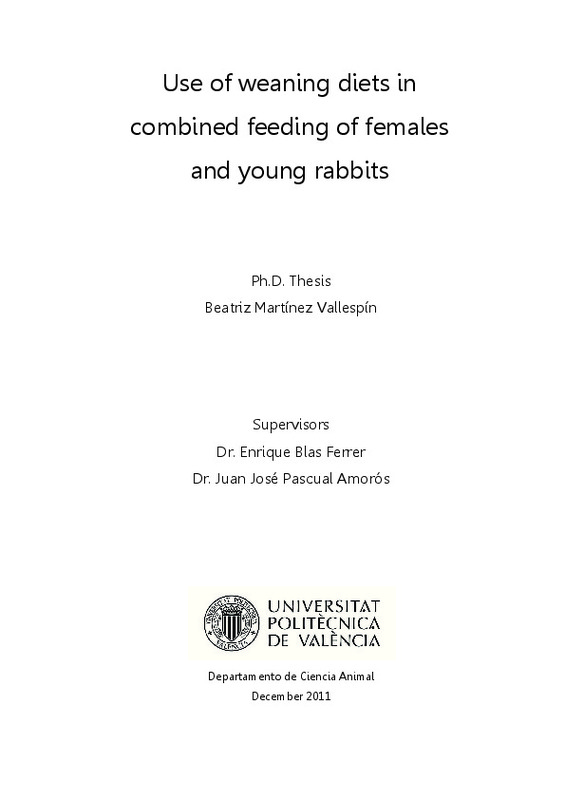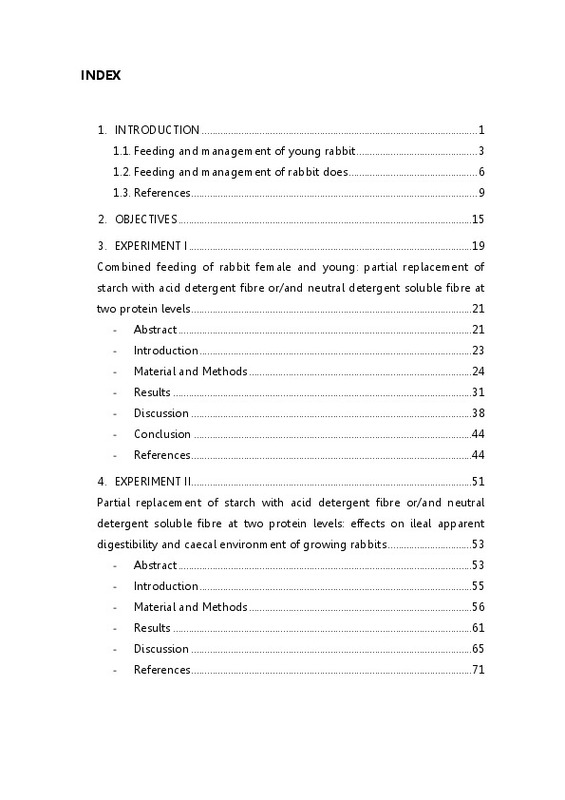- RiuNet repositorio UPV
- :
- Investigación
- :
- Tesis doctorales
- :
- Ver ítem
JavaScript is disabled for your browser. Some features of this site may not work without it.
Buscar en RiuNet
Listar
Mi cuenta
Estadísticas
Ayuda RiuNet
Admin. UPV
Use of weaning diets in combined feeding of females and growing rabbits
Mostrar el registro sencillo del ítem
Ficheros en el ítem
| dc.contributor.advisor | Blas Ferrer, Enrique
|
es_ES |
| dc.contributor.advisor | Pascual Amorós, Juan José
|
es_ES |
| dc.contributor.author | Martínez Vallespín, Beatriz
|
es_ES |
| dc.date.accessioned | 2011-12-23T10:31:43Z | |
| dc.date.available | 2011-12-23T10:31:43Z | |
| dc.date.created | 2011-12-16T09:00:00Z | es_ES |
| dc.date.issued | 2011-12-23T10:31:41Z | es_ES |
| dc.identifier.uri | http://hdl.handle.net/10251/14122 | |
| dc.description.abstract | The thesis sets out the design of new feeding strategies in the current context of rabbit production, marked by the high prevalence of Epizootic Rabbit Enteropathy and the need of the systematical use of antibiotics as the only way to maintain the digestive health of growing rabbits, and, consequently, the economical viability of the farms. In this context, the study is focused in the use of weaning diets in combined feeding of rabbit does and litters. In the first experiment, eight weaning diet were tested; they were formulated in a factorial design 2Œ2Œ2 with the following factors: i) partial replacement of starch with acid detergent fibre, ii) partial replacement of starch with neutral detergent soluble fibre and iii) reduction in the crude protein content. The three strategies impaired milk yield and body condition of rabbit does and decreased litter weight at weaning; however, they decreased the post-weaning mortality of young rabbits, and those effects seem to be additive. In the second experiment, the effect of those strategies on caecal environment of growing rabbits was tested. The dietary changes modified the production of volatile fatty acids (which increased) and/or ammonial nitrogen (which decreased), creating a more favorable environment to maintain the stability of caecal microbial ecosystem and, consequently, the digestive health, which would explain the reduction of mortality observed in the previous experiment. In the third experiment, a factorial design 2Œ2 was carried out to compare two feeding systems (conventional or the one based in the use of a weaning diet in combined feeding formulating the most favorable feed to digestive health of young rabbits, according to the results obtained in the two previous studies) and two weaning ages (28 or 42 days) in the long term (5 cycles). The results showed once again the conflict of interests between rabbit does production and young rabbits health. In this context, the work has been focused in the use of weaning diets in combined feeding of rabbit does and litters. | es_ES |
| dc.language | Inglés | es_ES |
| dc.publisher | Universitat Politècnica de València | es_ES |
| dc.rights | Reserva de todos los derechos | es_ES |
| dc.source | Riunet | es_ES |
| dc.subject | Combined feeding | es_ES |
| dc.subject | Rabbit | es_ES |
| dc.subject | Weaning diet | es_ES |
| dc.subject | Fibre | es_ES |
| dc.subject | Starch | es_ES |
| dc.subject | Protein | es_ES |
| dc.subject.classification | NUTRICION Y BROMATOLOGIA | es_ES |
| dc.subject.classification | PRODUCCION ANIMAL | es_ES |
| dc.title | Use of weaning diets in combined feeding of females and growing rabbits | |
| dc.type | Tesis doctoral | es_ES |
| dc.identifier.doi | 10.4995/Thesis/10251/14122 | es_ES |
| dc.rights.accessRights | Abierto | es_ES |
| dc.contributor.affiliation | Universitat Politècnica de València. Departamento de Ciencia Animal - Departament de Ciència Animal | es_ES |
| dc.description.bibliographicCitation | Martínez Vallespín, B. (2011). Use of weaning diets in combined feeding of females and growing rabbits [Tesis doctoral]. Universitat Politècnica de València. https://doi.org/10.4995/Thesis/10251/14122 | es_ES |
| dc.description.accrualMethod | Palancia | es_ES |
| dc.type.version | info:eu-repo/semantics/acceptedVersion | es_ES |
| dc.relation.tesis | 3719 | es_ES |
Este ítem aparece en la(s) siguiente(s) colección(ones)
-
Tesis doctorales [5389]







![Text file [Text]](/themes/UPV/images/text.png)


